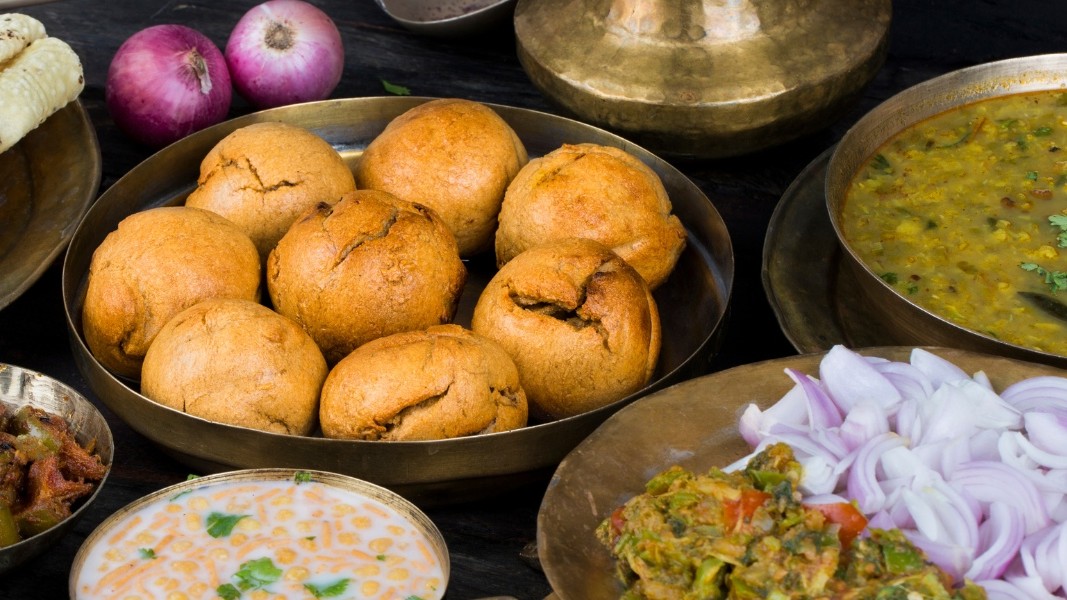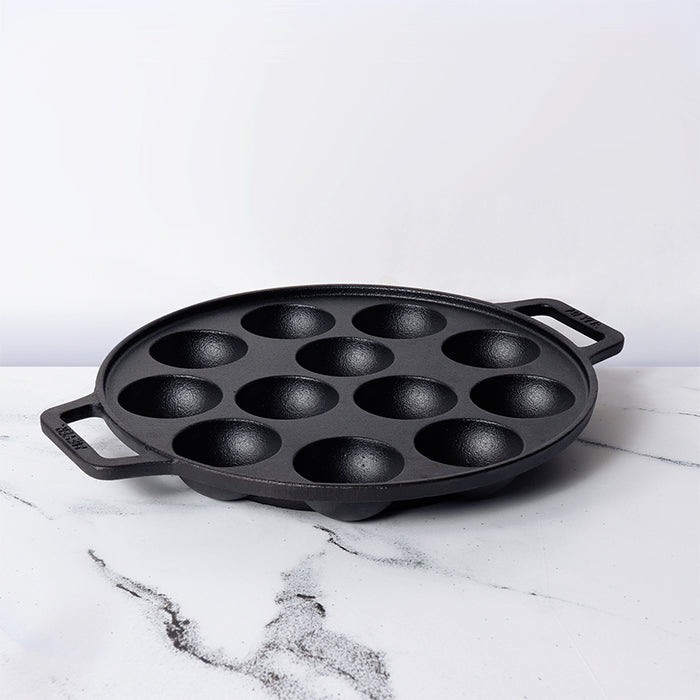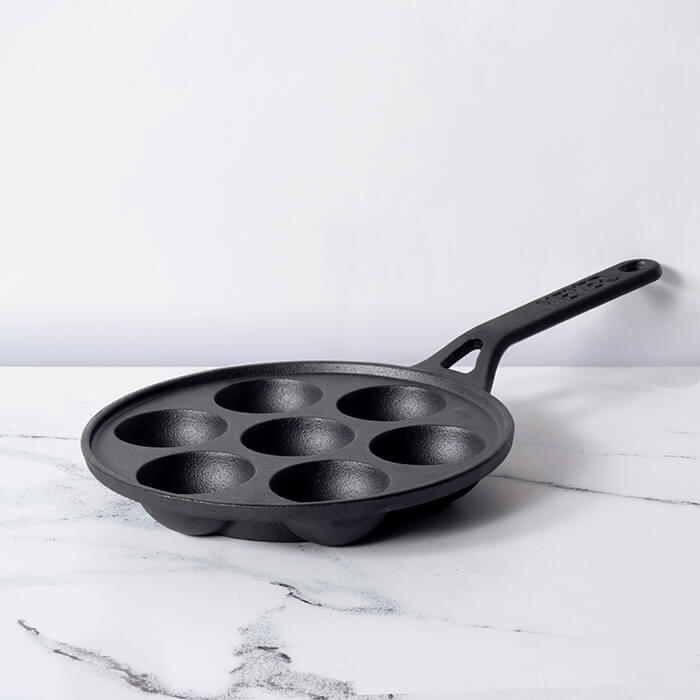Discovering the Recipe of Rajasthan: A Comprehensive Guide to Dal Baati Delight
Embark on a fascinating journey through the heartland of Rajasthan with our comprehensive guide to Dal Baati. Uncover the intricate details, regional nuances, and cultural significance of this iconic dish as we delve deep into the soul of Rajasthani cuisine, skillfully preparing it at home with the Meyer Cast Iron Paniyaram Pan.
Table of Contents
What is Dal Baati?
Dal Baati is a culinary masterpiece hailing from the arid lands of Rajasthan, comprising baked wheat balls (baatis) paired with flavorful lentils (dal). The baatis, cooked to golden perfection, are served with a medley of spices, creating a symphony of textures and tastes that define the rich culinary heritage of the region.
Significance of Dal Baati in Rajasthan:
- Cultural Emblem: Dal Baati is more than a dish; it's a cultural emblem representing the essence of Rajasthan.
- Familial Bonds: Rooted in tradition, it symbolizes the strengthening of familial bonds and togetherness during shared meals.
-
Celebratory Presence: Often featured in celebrations, festivals, and communal feasts, it becomes a culinary highlight that elevates the joyous atmosphere.
Different Types of Baati
- Classic Plain Baatis:
Timeless and cherished, the Classic Plain Baatis are the quintessential representation of traditional Rajasthani cuisine. Crafted from whole wheat flour, these baatis are rolled into round balls and baked to golden perfection. With a crispy exterior and a soft, fluffy interior, they embody simplicity and authenticity, providing the perfect canvas for savoring the rich flavors of Dal Baati.
- Spiced Renditions:
For those seeking an extra kick of flavor, Spiced Baatis come to the forefront. Infused with a medley of aromatic spices such as cumin, coriander, and ajwain, these baatis offer a burst of tantalizing taste with every bite. The infusion of spices not only enhances the overall flavor profile but also showcases the vibrant diversity of Rajasthani culinary creativity, adding a delightful twist to the traditional recipe.
- Stuffed Varieties:
Pushing the boundaries of culinary innovation, Stuffed Baatis are a gastronomic delight. Filled with delectable ingredients like spiced dal or mashed potatoes, these baatis elevate the dish to new heights, adding layers of taste and texture. The stuffing not only provides a burst of flavor but also creates a harmonious blend of textures, turning each bite into a delightful experience. Stuffed Baatis are a testament to the creative spirit embedded in Rajasthani cuisine, where innovation meets tradition.
More Delicious Recipes:
1. Punjabi Special Dal Makhani
2. Akki Roti: South India's Rice Flour Canva
3. Rajasthani special Ram Khichdi
How Different Regions of Rajasthan Eat Dal Baati:
Varied Preparations:
Example: In the Marwar region, the traditional Dal Baati Churma is a staple, where the baatis are baked and served with rich lentils and sweet churma. In Mewar, the baatis might be smaller in size and spiced differently, showcasing a regional twist on the preparation.
Distinct Presentations:
Example: In the Shekhawati region, the baatis are often presented uniquely, arranged artistically on the plate to create an appealing visual experience. This showcases the emphasis on presentation as a form of culinary art in the region.
Regional Accompaniments:
Example: Accompaniments like Ker Sangri pickle in the Thar Desert region or spicy garlic chutney in the Hadoti region are regional specialties that accompany Dal Baati. These variations add layers of flavor and contribute to the overall culinary narrative, showcasing the diverse tastes across Rajasthan.
Religious Connection of Dal Baati:
Spiritual Symbolism:
Example: During traditional ceremonies like weddings or religious festivals in Rajasthan, Dal Baati is often offered as Prasad (a religious offering). Its presence symbolizes the sanctity of the occasion and is believed to bring blessings to the participants.
Sacred Dining Experience:
Example: Families often come together for religious gatherings where Dal Baati is served. The act of sharing this meal becomes a sacred communal experience, fostering a sense of unity and spiritual connection among those partaking in the feast.
What is Baati Churma?
Delve into the sweet counterpart of Dal Baati with Baati Churma. Uncover the art of crafting this delightful dessert, where crumbled baatis combine with ghee and jaggery, creating a sweet symphony that perfectly complements the savory main dish.
Immerse yourself in the rich tapestry of Rajasthan's culinary heritage, unlocking the secrets of Dal Baati with in-depth insights and expert guidance for a truly authentic experience.
How to Make Dal Baati?
- Let’s start by making the masala. To make the masala, roast potatoes, tomato, green chillies and garlic over an open flame. Once they cool down, peel the skin off the potato and tomatoes and mash them in a plate along with the garlic and green chillies. Add the remaining ingredients mentioned for the masala and mix well and Keep aside.
- To make the dough, add all the ingredients mentioned for dough and knead into a tight dough. Allow the dough to rest for 15 minutes.
- Divide the dough into 8-10 small potions and Roll the divided dough into small rotis.
- Fill the potato masala in each of the dough pieces and wrap them into small balls as shown in the video.
- Add a little ghee in each cavity of the meyer cast iron paniyaram pan and put the bati in the cavity. Roast on low to medium heat until all the sides are cooked.
- Dip the cooked bati’s in ghee and serve hot.
Expert Tips
- Roasting the ingredients gives them a charred taste that truly compliments the baati and makes it truly delicious.
- Make sure to roll the dough thin as a thick sheet of dough takes longer to cook through and gives you a much more dense baati.
- Use an ample amount of ghee when cooking the baati to get the perfect crust outside.













Leave a comment